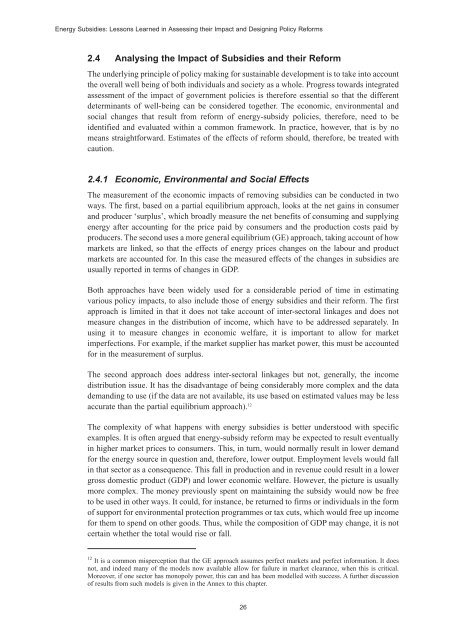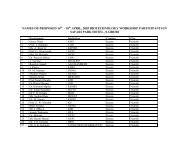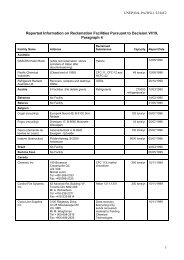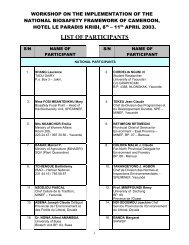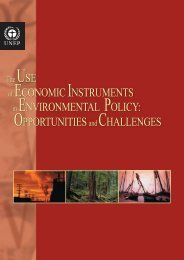Energy Subsidies: Lessons Learned in Assessing their Impact - UNEP
Energy Subsidies: Lessons Learned in Assessing their Impact - UNEP
Energy Subsidies: Lessons Learned in Assessing their Impact - UNEP
You also want an ePaper? Increase the reach of your titles
YUMPU automatically turns print PDFs into web optimized ePapers that Google loves.
<strong>Energy</strong> <strong>Subsidies</strong>: <strong>Lessons</strong> <strong>Learned</strong> <strong>in</strong> Assess<strong>in</strong>g <strong>their</strong> <strong>Impact</strong> and Design<strong>in</strong>g Policy Reforms<br />
2.4 Analys<strong>in</strong>g the <strong>Impact</strong> of <strong>Subsidies</strong> and <strong>their</strong> Reform<br />
The underly<strong>in</strong>g pr<strong>in</strong>ciple of policy mak<strong>in</strong>g for susta<strong>in</strong>able development is to take <strong>in</strong>to account<br />
the overall well be<strong>in</strong>g of both <strong>in</strong>dividuals and society as a whole. Progress towards <strong>in</strong>tegrated<br />
assessment of the impact of government policies is therefore essential so that the different<br />
determ<strong>in</strong>ants of well-be<strong>in</strong>g can be considered together. The economic, environmental and<br />
social changes that result from reform of energy-subsidy policies, therefore, need to be<br />
identified and evaluated with<strong>in</strong> a common framework. In practice, however, that is by no<br />
means straightforward. Estimates of the effects of reform should, therefore, be treated with<br />
caution.<br />
2.4.1 Economic, Environmental and Social Effects<br />
The measurement of the economic impacts of remov<strong>in</strong>g subsidies can be conducted <strong>in</strong> two<br />
ways. The first, based on a partial equilibrium approach, looks at the net ga<strong>in</strong>s <strong>in</strong> consumer<br />
and producer ‘surplus’, which broadly measure the net benefits of consum<strong>in</strong>g and supply<strong>in</strong>g<br />
energy after account<strong>in</strong>g for the price paid by consumers and the production costs paid by<br />
producers. The second uses a more general equilibrium (GE) approach, tak<strong>in</strong>g account of how<br />
markets are l<strong>in</strong>ked, so that the effects of energy prices changes on the labour and product<br />
markets are accounted for. In this case the measured effects of the changes <strong>in</strong> subsidies are<br />
usually reported <strong>in</strong> terms of changes <strong>in</strong> GDP.<br />
Both approaches have been widely used for a considerable period of time <strong>in</strong> estimat<strong>in</strong>g<br />
various policy impacts, to also <strong>in</strong>clude those of energy subsidies and <strong>their</strong> reform. The first<br />
approach is limited <strong>in</strong> that it does not take account of <strong>in</strong>ter-sectoral l<strong>in</strong>kages and does not<br />
measure changes <strong>in</strong> the distribution of <strong>in</strong>come, which have to be addressed separately. In<br />
us<strong>in</strong>g it to measure changes <strong>in</strong> economic welfare, it is important to allow for market<br />
imperfections. For example, if the market supplier has market power, this must be accounted<br />
for <strong>in</strong> the measurement of surplus.<br />
The second approach does address <strong>in</strong>ter-sectoral l<strong>in</strong>kages but not, generally, the <strong>in</strong>come<br />
distribution issue. It has the disadvantage of be<strong>in</strong>g considerably more complex and the data<br />
demand<strong>in</strong>g to use (if the data are not available, its use based on estimated values may be less<br />
accurate than the partial equilibrium approach). 12<br />
The complexity of what happens with energy subsidies is better understood with specific<br />
examples. It is often argued that energy-subsidy reform may be expected to result eventually<br />
<strong>in</strong> higher market prices to consumers. This, <strong>in</strong> turn, would normally result <strong>in</strong> lower demand<br />
for the energy source <strong>in</strong> question and, therefore, lower output. Employment levels would fall<br />
<strong>in</strong> that sector as a consequence. This fall <strong>in</strong> production and <strong>in</strong> revenue could result <strong>in</strong> a lower<br />
gross domestic product (GDP) and lower economic welfare. However, the picture is usually<br />
more complex. The money previously spent on ma<strong>in</strong>ta<strong>in</strong><strong>in</strong>g the subsidy would now be free<br />
to be used <strong>in</strong> other ways. It could, for <strong>in</strong>stance, be returned to firms or <strong>in</strong>dividuals <strong>in</strong> the form<br />
of support for environmental protection programmes or tax cuts, which would free up <strong>in</strong>come<br />
for them to spend on other goods. Thus, while the composition of GDP may change, it is not<br />
certa<strong>in</strong> whether the total would rise or fall.<br />
12 It is a common misperception that the GE approach assumes perfect markets and perfect <strong>in</strong>formation. It does<br />
not, and <strong>in</strong>deed many of the models now available allow for failure <strong>in</strong> market clearance, when this is critical.<br />
Moreover, if one sector has monopoly power, this can and has been modelled with success. A further discussion<br />
of results from such models is given <strong>in</strong> the Annex to this chapter.<br />
26


